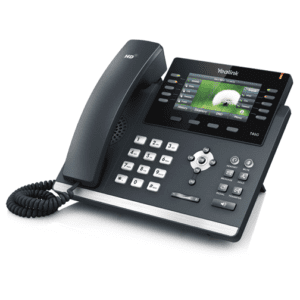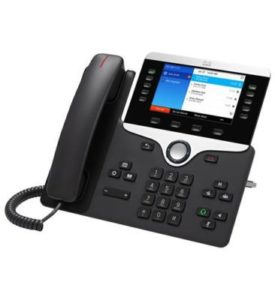Compare Upfront Costs, Unique Benefits & More Before Diving In
On-premises VoIP systems have been around for quite some time, but with the increase of cloud-based technology offerings, managed and hosted VoIP solutions are becoming viable alternatives. Self-managed on-premises systems give companies full control but often have a higher upfront cost, while managed on-premises or hosted systems often have a lower cost but give businesses much less managerial control. Choosing one of these solutions can be difficult. But if you look at your infrastructure capabilities, compare costs, and weigh the pros and cons of each system, you should be able to find a VoIP solution that will meet your needs without exceeding your budget.
Analyze Your Infrastructure
Before you start examining the unique features of on premises, self-managed VoIP or hosted VoIP solutions, you should look at the capabilities of your existing infrastructure, including your network bandwidth and cabling. According to Brett Femrite, director of business development at Rackmount Solutions (www .rackmountsolutions.net), you have to ask yourself, “Do I have the appropriate cabling infrastructure in place to support the VoIP solutions? Are there dual CAT 5 drops to each workstation, or am I having to daisy chain my workstation PCs into the phone and the VoIP into the jack?” Depending on your answers, your infrastructure might not even be able to support in-house VoIP, which will limit your choices.
On top of infrastructure, you also have to analyze your work force. You may have employees that are familiar with using VoIP solutions but don’t have the expertise to manage them. If this is the case, you would have to hire new employees or bring in an outside expert to train members of your IT department, which all adds to the upfront costs related to setting up an on-premises, self managed VoIP system.
Upgrade Or Make The Move
Some companies may already have an on-premises VoIP system in place but are looking at either upgrading it or switching to a hosted alternative. There are a few signs that it may be time to upgrade, including failing equipment, expensive maintenance, or staff complaints about the current low-tech offering, says Daniel O’Connell, research director for the Enterprise Service group at Gartner. Depending on the state of your infrastructure and current VoIP solution, a simple upgrade may be enough to meet your changing VoIP needs. In some cases, however, it may be more cost-effective to switch over to a hosted solution that can provide faster speeds and better overall performance at a lower price. O’Connell says that hosted solutions may be more beneficial for SMEs or highly distributed businesses that have difficulty managing an in-house VoIP system. Instead of spending money upgrading your existing systems or hiring more personnel, you can pass the management responsibilities on to a third party vendor and focus on using the system, instead of controlling and managing it.
Key Points
- Look at your infrastructure capabilities and make sure you are even in a position to manage a VoIP solution. If you already have one in place, decide whether to upgrade it or move to a third-party alternative.
- Compare the total cost of ownership of in house, managed, or hosted VoIP systems and consider the long-term and short-term costs of each option.
- If you choose a third-party VoIP solution, choose wisely between an on-premises managed solution and a fully hosted one. Determine how much control you want over the system.
Action Plan
The following steps were provided by James McCloskey, senior research analyst at Info-Tech Research:
- Inventory your existing telecom services, including circuits, users, functionality, capacity, and workload.
- Understand near-term and future growth needs in terms of users, advanced features, and related capabilities, such as unified communication, videoconferencing, or mobility.
- Identify your options. This includes upgrading or extending your current system, replacing it with a new on premises or managed system, or moving to a fully hosted version.
- Understand the capabilities and lifecycle costs associated with the various options.
- Make your selection and implement it, taking great care to ensure it is flexible enough to keep up with your company’s changing needs.
Get Started
Look at the size of your company and the number of employees that will need to access the VoIP solution. If your company has fewer than 250 employees, you may be able to put an on-premises VoIP system in place that will perform well and be easy to manage. However, if your company has more than 250 employees or is spread out over multiple satellite offices, then allowing a third-party provider to manage every facet of your enterprise’s VoIP system may be a less expensive alternative as well as a headache reliever for your IT department.

Managed On-Premises vs. Hosted
If in the end you decide that a third-party managed solution is the answer to your problems, you then have to decide between a managed on-premises approach and a hosted alternative. With managed on-premises VoIP solutions, you are responsible for purchasing or leasing hardware and software for the VoIP solution and implementing it. The service provider is simply responsible for managing your VoIP solution and helping with any issues along the way. With a hosted solution, you still have phones and other communication tools onsite, but the actual network connection and VoIP system are managed and hosted by the third-party vendor. In the short term, hosted VoIP is one of the least expensive and most adaptable choices, because “capital expenditures are minimized and subscription pricing provides substantial flexibility for adding or changing services,” says James McCloskey, senior research analyst at Info-Tech Research. Both of these options will counteract the need for in-house personnel with VoIP management experience and help lower the costs associated with implementing a VoIP solution, whether it be through leasing or hosting. In the end, it depends on how much control your company wants over the system and determining whether a fully hosted solution would better fit the needs of the organization.
Compare The Costs
As with any major IT-related purchase, you have to consider the overall cost and what functionality you will receive for the price you pay. “With an in-house solution, you typically will have more upfront acquisition costs, but more control over your system for moves, additions, and changes,” Femrite says. “With a hosted solution, be sure to carefully examine the agreement and its response times for both standard charges and emergency situations, such as system outages.” Femrite says there are many financial factors related to choosing a VoIP solution that go beyond the cost of hardware, software, or hosted pricing. He recommends looking at the accounting aspects and tax advantages of each type of system and to calculate the total cost of ownership related to each type of VoIP solution. “A fixed monthly operating cost for a hosted solution can be desirable,” he says. “But the TCO over the life span of the system could in fact be less with an on-premises VoIP system.”
- Make sure a third-party VoIP vendor fully meets the current needs of your company as well as any that might arise in the future. Have a good idea of what direction your business is going and how quickly. This will help you choose a VoIP solution that is flexible enough for your company and has all the necessary features.
- Know the strengths of your workforce. Build a cost-benefit analysis of whether it’s worth it to train employees on how to manage a VoIP solution. If not, a managed or hosted VoIP system may be a better alternative.
- Consider system availability. With an in-house, self-managed VoIP system, you have more control over uptime and downtime. If a third party vendor has an outage, no matter how large or small, it could negatively affect the productivity of your employees.
If migrating to a VoIP service seems like a good fit for your business, check out our UCaaS Management service page under the Services menu here on our website to learn more about what our VoIP service offers.
Is VoIP Phone Service seem like a good fit for your business?
Contact us today for a free quote!


